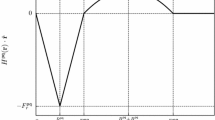Abstract
Biological systems are typically heterogeneous as individuals vary in their characteristics, their response to the external environment and to each other. For example, cell diversity plays a crucial role in the successful survival of many biological systems. Phenotypic heterogeneity is associated with cellular response to intercellular communications, the response to external environmental cues, motility modes, and proliferation rates. Here we study the effect of phenotypic diversity on the properties of collective motion in the context of the scalar noise model of collective migration. For simplicity, we study a population that is composed of two sub-populations, each with different sensitivities to external noise. We find that the two sub-populations interact non-additively: Within a large range of parameters, the dynamics of the system can be described by an equivalent homogeneous system with an effective temperature that depends on the average circular mean of the phenotypes. However, if one of the sub-populations is sufficiently “cold”, it dominates the dynamics of the group as a whole.









Similar content being viewed by others
References
Vicsek, T., Zafeiris, A.: Collective motion. Phys. Rep. 517, 71–140 (2012)
Couzin, I.D., Krause, J., Franks, N.R., Levin, S.A.: Effective leadership and decision-making in animal groups on the move. Nature 433, 513–516 (2005)
Mishra, S. Tunstrøm, K., Couzin, I.D., Huepe, C.: Collective dynamics of self-propelled particles with variable speed. Phys. Rev. E 86, 011901 (Jul 2012)
Menzel, A.M.: Collective motion of binary self-propelled particle mixtures. Phys. Rev. E 85, 021912 (2012)
Nagy, M., Daruka, I., Vicsek, T.: New aspects of the continuous phase transition in the scalar noise model (snm) of collective motion. Physica A 373, 445–454 (2007)
Vicsek, T., Czirók, A., Ben-Jacob, E., Cohen, I., Shochet, O.: Novel type of phase transition in a system of self-driven particles. Phys. Rev. Lett. 75, 1226–1229 (Aug 1995)
Toner, J., Tu, Y., Ramaswamy, S.: Hydrodynamics and phases of flocks. Ann. Phys. 318(1), 170–244 (2005)
Degond, P., Liu, J.-G., Motsch, S., Panferov, V.: Hydrodynamic models of self-organized dynamics: derivation and existence theory. Methods Appl. Anal. 20, 89–114 (2013)
Degond, P., Motsch, S.: Continuum limit of self-driven particles with orientation interaction. Math. Models Methods Appl. Sci. 18, 1193–1215 (2008)
Fisher, N.I.: Statistical Analysis of Circular Data. Cambridge University Press, New York (1993)
Grégoire, G., Chaté, H., Tu, Y.: Moving and staying together without a leader. Physica D 181(3), 157–170 (2003)
Grégoire, G., Chaté, H.: Onset of collective and cohesive motion. Phys. Rev. Lett. 92, 025702 (2004)
Binder, K.: Finite size scaling analysis of ising model block distribution functions. Zeitschrift für Physik B Condensed Matter 43(2), 119–140 (1981)
Cesa-Bianchi, N., Freund, Y., Haussler, D., Helmbold, D.P., Schapire, R.E., Warmuth, M.K.: How to use expert advice. Journal of the ACM (JACM), 44(3), 427–485 1997.
Baglietto, G., Albano, E.V., Candia, J.: Gregarious vs individualistic behavior in vicsek swarms and the onset of first-order phase transitions. Statist. Mech. Appl. Physica A 392(15), 3240–3247 (2013)
Acknowledgments
We thank two annonymous referees for useful comments and suggestions. GA acknowledges a Marie-Curie integration grant. EBJ was supported by a grant from the Tauber Family Funds and the Maguy-Glass Chair in Physics of Complex Systems and by the NSF Center for Theoretical Biological Physics, Grant No. PHY-1308264.
Author information
Authors and Affiliations
Corresponding author
Rights and permissions
About this article
Cite this article
Ariel, G., Rimer, O. & Ben-Jacob, E. Order–Disorder Phase Transition in Heterogeneous Populations of Self-propelled Particles. J Stat Phys 158, 579–588 (2015). https://doi.org/10.1007/s10955-014-1095-7
Received:
Accepted:
Published:
Issue Date:
DOI: https://doi.org/10.1007/s10955-014-1095-7




